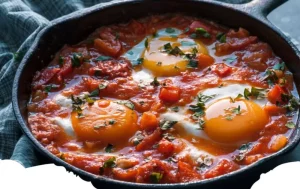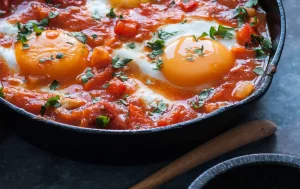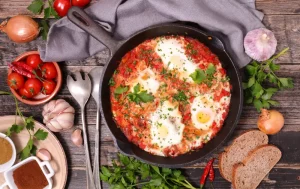The Global Journey of Shakshuka
Shakshuka’s journey from a regional specialty to a global sensation underscores the universal appeal of comfort food. Originating in the Middle East and North Africa, this dish has traveled far beyond its geographical roots, finding a place in the hearts and kitchens of people around the world. Its simple foundation of eggs poached in tomato sauce, enriched with spices, allows for endless innovation, making shakshuka a canvas for culinary creativity.
Cultural Adaptations and Innovations
As shakshuka has spread across continents, it has absorbed influences from various culinary traditions, leading to an array of variations. In some regions, local spices and ingredients are incorporated, creating unique versions that reflect the diverse tastes and traditions of each place. This adaptability has contributed to shakshuka’s popularity, allowing it to become a beloved dish in countless cultures.
The Art of Making Shakshuka
Creating shakshuka is as much about the process as it is about the ingredients. The dish begins with the creation of a rich, spiced tomato sauce, into which eggs are carefully cracked and allowed to poach to perfection. The choice of spices, the heat of the simmer, and the timing of the egg poaching are all crucial elements that contribute to the final flavor and texture of the dish. Mastery of these elements transforms simple ingredients into a meal that is both nourishing and flavorful.
Shakshuka in the Culinary World
In the culinary world, shakshuka is celebrated for its versatility and simplicity. It has inspired chefs and home cooks alike to experiment with different ingredients and techniques, elevating the dish to new heights. From upscale restaurants to home kitchens, shakshuka has become a symbol of how traditional dishes can be adapted and embraced by new audiences.
A Dish for All Occasions
Shakshuka’s appeal lies in its ability to fit any meal occasion, from a leisurely brunch to a comforting dinner. Its hearty nature and satisfying flavors make it ideal for gathering friends and family around the table. The act of breaking bread and sharing a skillet of shakshuka fosters a sense of community and warmth, embodying the essence of communal dining.
Shakshuka’s Enduring Legacy
The enduring legacy of shakshuka is a testament to the dish’s versatility, flavor, and simplicity. As it continues to be discovered and adapted by new generations, shakshuka remains a vibrant part of global cuisine. Its journey from a humble beginning to a worldwide phenomenon showcases the power of food to cross cultural boundaries, bringing people together through the universal language of delicious, comforting meals.






